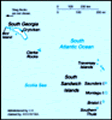Advertisement
Published: February 20th 2019
7. Gold Harbour, South Georgia
We travelled further south to Gold Harbour which was an exposed bay, but the swell had calmed from the morning state. The Captain navigated his way very close to the beach, so our zodiac ride was reasonable short. As usual, we scrubbed our rubber boots with biosecurity approved solution so that we didn’t carry any disease or foreign waste onto Sth Georgia. Before we set foot onto South Georgia the first time, we had to scrub everything, removing foreign material from all the Velcro using wire brushes and vacuum cleaners. We had to have our cleaning effort signed off by One Ocean staff. At our first stop we also had biosecurity Sth Georgia Government Officers check us before we entered their country. It was excellent to see. There was also a major rat problem several decades ago, killing some of the endemic birds and animals. Millions of dollars have been spent on eradication of the rats using helicopters to drop bate. The monitoring program continues, including ships having to carry rat monitors on board. It is the first rat eradication program on any island in the world that has been 100% successful.
We arrived safely on the beach and saw a large colony of King and Gentoo Penguins. Fur seams were also in abundance. Fur seals numbers are escalating throughout South Georgia but the experts say there is no need for alarm as there is plenty of food for the increased population.
What Gold harbour is most known for is their population of Elephant seals. We saw large numbers of juvenile Elephant seals (between 4-7 years old) in their moulting state. All the adult Elephant seals were out at sea feeding. These seals are known to dive 200m to the ocean floor for food and slow their heart rate down to 4-10 bps (from 120 bps on the surface), expelling 90% of their air out of their lungs and efficiently gliding through the water foraging extensively. They surface for 2 minutes, re-oxygenate then dive deeply again. Very interesting animals. They don’t start growing their long proboscis until after they are 7 years old.
To see a large group of Elephant seals lying on the beach, we had to walk through tussock grass, fighting off fur seals as we had become accustomed to doing. The
One Ocean staff would do a reconnaissance first, marking out the best track with tall orange poles. It was a good system.
After several hours we returned to the ship by zodiac and as always, downloaded our photos and relived our experience.
8. Cooper Bay, South Georgia
Every day on South Georgia has been beautiful weather. The locals and the One Ocean staff who were regular visitors, couldn’t believe that 4 days in a row was sunny. This was our luck.
The stunning scenery continued. This part of the journey included a 2 hour zodiac cruise where we visited much of the coastline of Cooper Bay. The bay was home to more large colonies of King and Gentoo and Chinstrap penguins. Some of the colonies were small but most were quite large, making their way up the side of the mountain. As usual on South Georgia, we saw plenty of fur seals including another honey blond seal, cormorants, Elephant seals and snowy sheathbill birds.
We watched the King penguins speedily porpoise their way across the bay, sometimes chasing our zodiac or leading it.
It was cold when we were going into the breeze, but we were well rugged up in our layers of clothes ad the waterproof overalls and jackets provided by One Ocean.
We went back to the ship in time for ‘happy hour’ which happened each night.
The zodiac tour of the Bay was the very last adventure on South Georgia. Wow, what experiences and incredible scenery. To celebrate, the company put on a special BBQ on the deck to say goodbye to Sth Georgia whilst floating around in the absolutely stunning snow-capped Drygalski Fjord. It was beautiful. The ship’s staff had cleared the front deck, setting up tables and chairs and the BBQ. We had spare ribs, prawns on a skewer, steak, chicken, fish and a beautiful array of salads. They also served hot mulled wine. We were all rugged up so was warm as toast!
We saw a sheet of ice float by with a Leopard seal resting on it. The sunset was beautiful against the multiple glaciers that surrounded us. The rugged mountains towered above us. It was obviously a deep fjord as the Captain slowly pivited the
ship around so that as we sat and enjoyed our dinner, the scenery continued t change. What a St Georgia finale! We went to bed very contented, knowing that we had seen the east coast extensively. The west coast is very uninviting for a ship due to the extensive permanent icefields.
South Georgia has been full of beautiful scenery, a thrilling location for history lovers and the rusting relics of the early whaling industry which were all around us. A highlight was a visit to Grytviken – the largest of the whaling stations, situated at the head of Cumberland Bay. It was here we visited the gravesite of Sir Ernest Shackleton. For many, being in the presence of the great explorer was a highlight of the trip. An excellent museum at Grytviken, maintained by the South Georgia Heritage Trust and the restored church built by the original Norwegian whalers provided a fascinating glimpse into the past. The land, sea and flying wildlife had been incredible.
It was now time for our 2 days at sea on the way to the Antarctic Peninsula.
Advertisement
Tot: 0.06s; Tpl: 0.015s; cc: 7; qc: 23; dbt: 0.0362s; 1; m:domysql w:travelblog (10.17.0.13); sld: 1;
; mem: 1.1mb























